Pelargonium
By Debs Cook
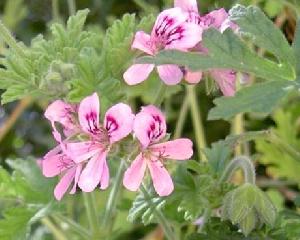
Pelargonium Graveolens
As most of my herbs are either in need or a haircut or sleeping waiting for the spring, my herb garden looks a little messy and devoid of life; so this month I thought I'd look forward to Summer, and write about the pelargonium or the scented geranium as this plant is more commonly known. Most people are familiar with the bedding variety of the pelargonium; it is hard to miss being planted en masse in parks and gardens country wide as summer bedding displays.
However, the pelargonium family contain some wonderful scented varieties that are often ignored for their larger-flowering showy counterparts. It is such a shame as these demure treasures provide interesting leaf shapes and colours, pretty flowers, ingredients for beauty products, culinary uses and they make a wonderful living pot-pourri. All this and they have the bonus of a large selection of scents to delight the senses.
History
Pelargoniums have a long history of use, although more for decorative purposes than for any other uses. They were discovered growing at the Cape of Good Hope in South Africa, in the early 1600s by Charles the first's botanist and chief plant finder John Tradescent (c1570-1638).
Growing scented geraniums became a popular pastime during the Victorian era in England. The Victorians would raise the plants in heated greenhouses. This scented geranium craze continued until 1914 when fuel to heat the greenhouses was banned due to the war, and the practice died away.
Folklore
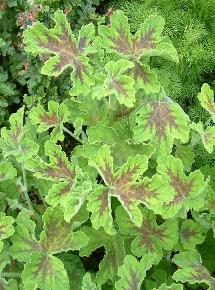
(P. 'Chocolate Peppermint')
In folklore the scented geraniums are said to be useful in matters of health, love and protection, as well as being good at banishing negativity and lifting the spirits. Regarded as a flower of remembrance, the pelargonium serves as a reminder to humanity that the past should be held in high regard and learned from.
Red pelargoniums in particular are considered to be especially protective, bringing strength to a person's health. When planted near the cottage of a witch, these flowers were reputed to warn the witch of strangers approach. Pink pelargoniums, especially the rose scented kind, are said to bring love, whilst the white variety is said to increase fertility. To dream of a scented geranium can indicate melancholy, stupidity or folly.
Old wives believed that all of the scented geraniums had mysterious magical properties, depending on their scent. For example the rose scented geraniums could bring love and the nutmeg scented geraniums could bring luck and help with money troubles.
Description
As I mentioned earlier, the scented pelargoniums are referred to as scented geraniums. Pelargoniums and geraniums are members of the same botanical family, Geramiaceae, and some varieties have similar looking foliage, which probably accounts for the two being identified as being the same plant.
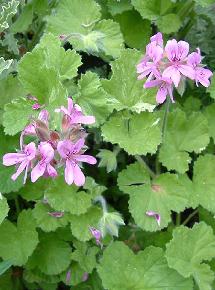
(P. 'Atomic Snowflake')
Our native 'true' geraniums include plants such as Herb Robert, which I'll cover in a future herb of the month article. True geraniums are often referred to as cranes-bill due to the shape of their seed head after the flowers fade, whilst pelargoniums are referred to as storks-bill.
The pelargoniums leaf colours range from dark green through to a very pale lime green and there are plenty of different variegated leaves that include red, cream and burgundy. The leaves can be deeply cut or frilled and may vary in size from 1 to 8 cm across. The flowers are borne in clusters and are long lived. The height of a plant can be anything from 30 to 90 cm. The flowers may be white, pink, purple, red or variegated and usually have no fragrance.
There are at least 150 different varieties of scented geranium, including mint, rose, apple, apricot, nutmeg, lemon, orange, lime, ginger, cinnamon and coconut, to name a few. Some of my favourites that grow in my garden include the rose scented Attar of Roses (P. capitatum), the lemon scented Mabel Grey (P. citronellum), the orange scented Prince of Orange (P. x citrosum) and the peppermint scented Peppermint Geranium (P. tomentosum). They all provide wonderful fragrance and have many uses in my home.
Growing
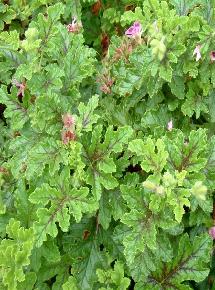
(Pelargonium Quercifolium)
Scented geraniums are considered tender perennials. Outside, they wither at the first sign of frost. But if you over-winter them indoors or in a warm greenhouse they will continue to thrive and possibly even keep producing flowers. Pelargoniums are well suited for growing in pots and hanging baskets, since they like their roots to be restricted, but don't let them become pot bound, they won't thank you for that. They prefer warm conditions, bright direct sunlight and excellent drainage, even preferring to be kept a little on the dry side. Never overfeed your scented geraniums; too much nitrogen from the plant food will cause your plant to produce a weak scent, even if it will improve the flowers.
General Use
It was once thought that the lemon scented geranium placed on a windowsill could prevent flies from entering the house. In later years this has been disproved, but they're still worthy of a place on the windowsill. The dried leaves can be used in bath sachets and pot-pourri. Rose geranium can be used for facial steams as it is reputed to have anti-aging effects on the skin. The fresh leaves can be infused in bath water or used in the final rinsing water for your hair.
Medicinal Use
Rose geranium is an excellent emotional stimulant and a wonderful mood enhancer. It makes a wonderful pick-me-up massage when diluted with sweet almond oil, and is also useful as a massage oil, once again when diluted, to help relieve woman's monthly troubles. Make a bath by putting leaves and flowers in a muslin bag and hang under the bath tap whilst it is running. Use with caution if you have sensitive skin, as in some people the essential oil can cause a mild rash.
Culinary Use
In the kitchen, scented geraniums are used in the making of sweet syrups to be added to puddings, sweets and drinks. Warning: Do not use any of the P. crispum varieties e.g. Lemon Crispum in cooking, they are said to cause stomach upsets. Rose scented geranium is often used to make a jelly that is perfect companion to meats and for a filling for cakes. Try adding a few leaves such as the spicy or rose scented ones to milk, gently warm the milk to release the scent of the leaves (remember not to use the crispum varieties). Then add the infused milk to custards, puddings, or sauces. Fresh leaves can be added to fruit dishes and used as a garnish.
You can place the leaves in castor sugar to make a variety of scented sugars for use in cakes and desserts. You can also make a pretty cake decoration by placing scented geranium leaves on top of a cake and dusting them with icing sugar, then carefully removing them to leave a pretty leafy design on top of the cake.
Recipe:
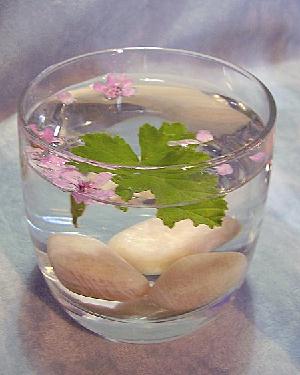
Cosmetic Rose Geranium Water
(for external use only)
- 15 x Rose Scented Geranium Leaves
- 200ml Purified Water
- 100ml Pure Rose Water Hydrolate
- 3 Drops Rose Geranium Essential Oil
- 1 Tsp Benzoin Tincture
Place the leaves in a pan with the purified water and simmer together for 15 minutes, then turn off the heat and leave to steep for 4 hours.
Strain the leaves from the liquid and add the liquid to the rose water.
Stir in the rose geranium oil and benzoin tincture, bottle and label.
NB the Benzoin tincture acts as a preservative. It can be omitted if you don't intend to keep the rose geranium water for long.
